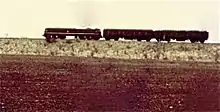| British Rail 18100 | |||||||||||||||||||||||||||||||||
|---|---|---|---|---|---|---|---|---|---|---|---|---|---|---|---|---|---|---|---|---|---|---|---|---|---|---|---|---|---|---|---|---|---|
 | |||||||||||||||||||||||||||||||||
| |||||||||||||||||||||||||||||||||
| |||||||||||||||||||||||||||||||||
| |||||||||||||||||||||||||||||||||
| |||||||||||||||||||||||||||||||||
British Rail 18100 was a prototype main line gas turbine-electric locomotive built for British Railways in 1951 by Metropolitan-Vickers, Manchester. It had, however, been ordered by the Great Western Railway in the 1940s, but construction was delayed due to World War II. It spent its working life on the Western Region of British Railways, operating express passenger services from Paddington station, London.
Overview
It was of Co-Co wheel arrangement and its gas turbine was rated at 3,000 horsepower (2,200 kW). It had a maximum speed of 90 mph (140 km/h) and weighed 129.5 long tons (131.6 t; 145.0 short tons). It was painted in BR black livery, with a silver stripe around the middle of the body and silver numbers.
Technical details
The gas turbine was of a type which would now be called a turboshaft engine but it differed from modern free-turbine turboshaft engines in having only one turbine to drive both the compressor and the output shaft. It was based on aircraft practice and had six horizontal combustion chambers (spaced radially around the turbine shaft) and no heat exchanger.
The emphasis was on power, rather than economy, and the fuel consumption was high. It was designed to use aviation kerosene and was much more expensive to run than No. 18000, which used heavy fuel oil. The turbine drove, through reduction gearing:
- three main generators
- one auxiliary generator for battery charging
- one exciter for the main generators
Each main generator powered two traction motors. Unlike No. 18000, there was no auxiliary diesel engine and the turbine was started by battery power, using the main generators as starter motors.
Comparison of 18000 and 18100
The following table gives a comparison between 18000 and 18100. There are some anomalies and these are described in the notes.
| Value | 18000 | 18100 | Notes |
|---|---|---|---|
| Weight (tons) | 115 | 129 | - |
| Turbine horsepower | 10,300 | 9,000 | (1) |
| Power absorbed by compressor | 7,800 | 6,000 | (1) |
| Output horsepower | 2,500 | 3,000 | (1) |
| Number of traction motors | 4 | 6 | - |
| Total traction motor horsepower | 2,500 | 2,450 | (2) |
| Starting tractive effort (lbf) | 31,500 | 60,000 |
Notes:
- In 18000, output horsepower is 24% of total horsepower and in 18100, output horsepower is 33% of total horsepower. This suggests that 18100 had the higher thermal efficiency but, in practice, 18000 had the higher thermal efficiency. The horsepower figures should, therefore, be regarded with some scepticism.
- Where electric transmission is used, the horsepower of the traction motors is usually 81% (i.e. 90% x 90%) that of the prime mover. The figure for 18100 is therefore about right but the figure for 18000 looks anomalous.
Conversion

In early 1958 it was withdrawn from operation and was stored at Swindon Works for a short period before it was returned to Metropolitan Vickers for conversion as a prototype 25 kV AC electric locomotive. As an electric locomotive, it was numbered E1000 (E2001 from 1959) and was given the TOPS classification of class 80.[1]
See also
Models
18100 is being made as a kit and ready-to-run in OO gauge by Silver Fox Models.[2]
References
- ↑ Marsden & Fenn 2001, p. 59
- ↑ "18100 Co-Co Metropolitan-Vickers Gas Turbine". Archived from the original on 21 April 2013. Retrieved 17 November 2012.
Sources
- Marsden, Colin J.; Fenn, Graham B. (2001). British Rail Main Line Electric Locomotives (2nd ed.). Oxford Publishing Co. ISBN 9780860935599. OCLC 48532553.
- Sampson, H. (editor), The Dumpy Book of Railways of the World, published by Sampson Low, London, date circa 1960
- Robertson, K. (1989). The Great Western Railway Gas Turbines, published by Alan Sutton, ISBN 0-86299-541-8
- Strickland, David C. (1983). D&EG Locomotive Directory, every single one there has ever been. Camberley, Surrey: The Diesel & Electric Group. ISBN 0-906375-10-X.
Further reading
- Marsden, Colin J.; Fenn, Graham B. (1988). British Rail Main Line Diesel Locomotives. Sparkford: Haynes. pp. 52–55. ISBN 9780860933182. OCLC 17916362.
- "No.18100, the first British built gas turbine locomotive". RAIL. No. 102. EMAP National Publications. 10–23 August 1989. pp. 34–39. ISSN 0953-4563. OCLC 49953699.
External links
- Rail Photo Archive - 18100
- Photo of 18100 under construction
- "Turbine Speeds British Trains" Popular Science, April 1952, p. 131, mid-page